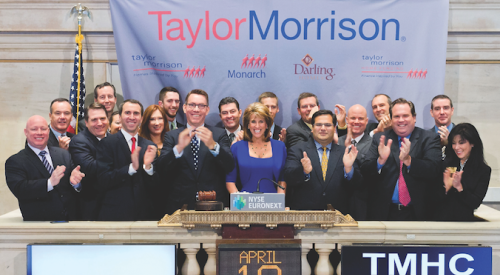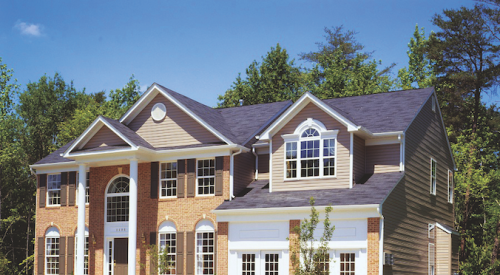Every year, Professional Builder’s Housing Giants survey asks builders to name the most significant change they made in their company in the previous year and its impact on their business. As builders completed their surveys in the early months of 2012, there was an odd, new feeling that crept into the responses. It felt vaguely familiar — something we remembered from some bygone time, but we couldn’t quite put our finger on it because it had been so long since we’d seen it.
Then it hit us. It was optimism. Cautious optimism, to be sure, but it was there nonetheless.
Builders said they were reducing debt and emerging from bankruptcy. They were hiring and adding new floor plans. They were expanding into new markets. They even were — and we are not making this up — raising prices. Keystone Custom Homes in Lancaster, Pa., said they opened 17 new communities “in the worst year of housing on record to drive success in 2012” and have opened another seven since then, for a total of 24 new communities in 11 months. In the first quarter of 2012, Keystone sold 161 homes — the best quarter in the company’s 20-year history. “It’s been a fun ride,” Keystone president Larry Wisdom says.
Housing Giants Report Contents
• Introduction
• Housing Giants Rankings
• 5 Takeaways From the Housing Giants Report
• The Innovators: Great Ideas From the Giants
• Next Move: Giants Share Their Top Opportunities for 2012 and Beyond
• Sales Strategies: What’s Working for the Giants
In looking ahead to 2012, we asked builders about areas of opportunity. Specifically, we asked about the economy, niche markets, market expansion, better product, operational efficiency, acquisitions, joint ventures, and other opportunities. Here’s a recap of some of the responses we received:
David Weekley Homes
Houston
Housing Giants rank: 17
Chairman David Weekley says he sees a real opportunity this year in what he calls “central living,” essentially infill development. “They’re complicated to do because they’re smaller tracts of land,” says Weekley. “Most builders won’t do them because it’s high-level management for a small number of homes. The small guys who used to do them can’t anymore because they can’t get the financing.”
Another segment his company is going after is high-end custom homes in the $600,000 to $1 million range. Weekley says his company did a great business in this segment after the downturn in Houston in the mid-80s. Now, like then, the custom builders who typically built those houses have gone out of business. It will take them six to eight years to come back, Weekley predicts. In the meantime, it’s a great opportunity for his company.
“It’s very opportunistic,” he notes. “It’s not volume business; it’s specialty business. It’s not easy by any stretch of the imagination. Our team is used to doing that.”
The company also has made a big investment in technology, both in a website redesign and in customer engagement. Sales centers and model homes have been redesigned to accommodate intuitive, touch-screen kiosks. “We want to catch people where they’re most comfortable,” Weekley says.
Bill Beazley Homes
Evans, Ga.
Housing Giants rank: 181

To differentiate from what other builders are offering in its markets, Evans, Ga.-based Bill Beazley Homes expanded its elevation offerings to include stone, fiber-cement siding, and cedar plank, among other exterior options.
This long-time Augusta, Ga.-area builder sees an opportunity in 2012 for market expansion. The builder just opened a new subdivision called Hayne’s Station close to the main gate at Fort Gordon, an Army post that houses a National Security Agency facility that will ultimately employ 4,000 people.
To differentiate from what other builders are offering in the market, Bill Beazley VP Susan Erway says that they are offering a different set of elevations — including stone, fiber-cement siding, and cedar plank — than in the past. “It will have a very different feel,” she says. “Years ago, the thing was four-sided brick. We’ve done that for decades. We have to follow the market.”
Epcon Communities
Dublin, Ohio
Housing Giants rank: 36
Ed Bacome and his partner Phil Fankhauser see plenty of opportunity in 2012. The active-adult builder traditionally has exclusively built attached condos, but has added a single-family detached product line. The builder also expanded into Raleigh and Charlotte, N.C., and Charleston, S.C.
The top challenge for its customers in recent years has been the ability to sell their existing homes. Bacome says the Home Equity Conversion Mortgage (HECM), a reverse mortgage product, was a valuable tool for their buyers in 2011 and will continue to be important this year.
“We used to get a contract that said HECM, and I’d be a little suspect, a little nervous,” says Bacome. “Now when I see HECM, I think it’s an opportunity for another sale.”
Taylor Morrison
Scottsdale, Ariz.
Housing Giants rank: 15

Taylor Morrison’s Houston division recently opened its Interactive Home, a pie-in-the-sky house with high-end amenities and gagets like a remote wireless home control system.
Graham Hughes, national VP for sales and marketing, calls himself an eternal optimist. This year, he’s fairly gushing about the possibilities.
“Since last October, sales have been unbelievable,” he says. “We’re hiring people all over the place. We’re getting valuations from appraisers. Last month, for the first time in four or five years, we actually increased prices in Phoenix. It’s really, really exciting.”
The company also is looking at new niche markets, including active adult, smaller townhome products, and infill in various cities. Its Houston division just launched the Interactive Home, a “pie-in-the-sky house with what everybody thought they wanted but had never been affordable,” says Hughes; it features a remote wireless home control system. That’s getting ready to go national, he says.
In a stunning turnaround, Taylor Morrison’s Phoenix division — a market that had been decimated in the downturn — has now returned to its position as the company’s top-selling division. First the Canadians and snowbirds started buying again, and now the local buyers are back as well.
One thing that won’t happen again at Taylor Morrison, Hughes says, is being a “fat” company.
“I’d love to say we never were, but of course we were,” he says. “Cost is not a big deal when you’re raising your price 20 percent every five minutes. I do not want to go back to 2004-2005, never ever ever.”
Fischer Homes
Crestview Hills, Ky.
Housing Giants rank: 40
Housing Giants' Top Opportunities and Hurdles
TOP OPPORTUNITIES
Operational efficiencies 47%
Niche market opportunities 43%
Market expansion 37%
Better product marketing or expanded services 30%
Economic recovery 25%
Joint venture opportunities 15%
Mergers/acquisitions 4%
TOP HURDLES
Business banking – project funding 28%
Continued softness in home prices 27%
Ongoing recession 25%
Mortgage banking – getting customers qualified 25%
Competition from other builders 23%
Changing appraisals/low appraisals 21%
Marketing: finding qualified buyers and prospects 18%
BASE: 230 | SOURCE: PROFESSIONAL BUILDER HOUSING GIANTS REPORT, 2012
The Housing Giants survey asked builders to identify their top opportunities and hurdles heading into 2012. Operational efficiencies topped the list.
Fischer Homes has spent the last few years being “fairly aggressive” acquiring distressed lots and land, typically with very low leverage or none at all. “We’re trying to position ourselves so that when the market does improve, we’re in a position to capitalize on that,” says president Bob Hawksley. The company has allocated more capital this year for additional acquisitions.
“What we really expect is as the market improves, we’ll see we have the right land in the right places, and fewer people who can compete with us as land gets scarce,” he says.
Fischer Homes also is making a push to bring out a more diverse range of products. The company has “always done something different,” he says, including larger front setbacks, side-entry garages, a wide variety of elevation influences, and included landscaping.
“We’re turning that up another notch,” he says, “adding additional styling.” He’s contracted with a new group of nationally known architects (he declined to name them) who will “wake us up if there are trends going on.”
AvalonBay Communities
Arlington, Va.
Housing Giants rank: 28
Apartment community developer AvalonBay is delving deeper into niche markets in 2012 with the launch of two new brands. Its core brand, Avalon, is a high-end luxury product. It has added Ava, which is meant to target a younger demographic in emerging “cool” big cities with locations near transit, senior director of investor relations John Christie says. The third brand is Eaves by Avalon; those properties are older, Class B properties in good locations. “We’re trying to diversify our asset base; there’s a risk in doing that with one brand because it dilutes the brand.”
The company also has moved its back office operations to an off-site customer care center. “It takes a lot of the work that leasing agents do on site and moves it off site,” says Christie. “This allows leasing agents to do what they’re hired to do — lease apartments.”
Gehan Homes
Dallas
Housing Giants rank: 34

In order to target higher-end buyers, Dallas-based Gehan Homes recently debuted an estate series which offers homes that are 70 feet wide — 35 percent wider than the builder’s typical home.
CEO Tim Gehan is looking for a 10 percent increase in sales in 2012 over the 1,000 homes his company built in 2011. “We have a shot of exceeding our plan but it’s too early to tell,” he says. He’s maintaining his focus on reducing cycle time for this year, as well as simplifying the company’s line up of floor plans. He doesn’t want more than six to eight plans in each price point.
“We try not to have a significant number of plans because of the pressure it puts on the purchasing department and data entry to maintain an option catalog in these plans,” he says.
Currently, Gehan Homes sells houses that are 40 or 50 feet wide, with structural options to add on to that. His team is working on an estate series that will be 70 feet wide; that’s part of the company’s effort to move into a higher price point.
Like other builders, Gehan says he has seen a shift in buyer optimism that started in the third quarter of 2011. “It felt like we gained momentum in 2011. I think that momentum is continuing. We’re well ahead of our 2011 first quarter this year.”
To stay ahead of the demand, Gehan says he’s working hard to maintain an adequate supply of lots.
“Eighteen months ago we had one guy in the land department statewide,” he says. “Now we have about 10. A lot of that is very recent. It sounds ridiculous to say out loud — I go to consultant meetings and they talk about thousands and thousands of finished lots, but in many cases they’re in places where people don’t want to buy houses. We are very concerned about that.”
McGuinn Homes
Lexington, S.C.
Housing Giants rank: 216
McGuinn Homes is another builder that anticipates doubling its sales in 2012. CEO Wade McGuinn spent much of the downturn focusing on acquiring lots so that when the market turned, they’d be ready. His sales for the first quarter of 2012 are about 40 percent ahead of projects, he says.
“What’s the magic bullet? It’s 100 magic bullets,” says McGuinn. “The customer is all about efficiency. There is no urgency in the marketplace. What will you do to compel the customer to get off their couch and get a moving van? It better be compelling — quality, price, delivery, location — because they want it all and they’re going to get it.”
He also sees opportunity in market expansion. He sees a “complete gap” of 200 potential sales between the northern suburbs of Columbia, S.C., and the southern suburbs of Charlotte, N.C., so he’s opened a build-on-your lot division. He says he’ll probably do the same thing between Columbia and Augusta, Ga., to the southwest and Columbia and Charleston to the southeast.
“Our growth will be rural growth,” he says.
Habitat for Humanity International
Americus, Ga.
Housing Giants rank: 22
Habitat affiliates are using a diverse mix of housing options to help families in need. During this difficult economic time, Habitat initiated its Neighborhood Revitalization Initiative, which expanded its services to include a strong focus on rehabilitations, repairs, weatherization, and local community planning, in addition to new construction.
Habitat affiliates are coordinating with other organizations on collaborative and strategic community planning and, in many communities, are acquiring and rehabilitating vacant properties and selling them to families in need of affordable housing.
Habitat’s repair programs include A Brush With Kindness, which targets exterior home preservation; Critical Home Repair, which can involve both interior and exterior repair work and, if needed, accessibility modifications; and Weatherization, which helps families improve the energy efficiency of their homes. Habitat’s Repair Corps program makes these repair services available for veterans who reside in their homes.














